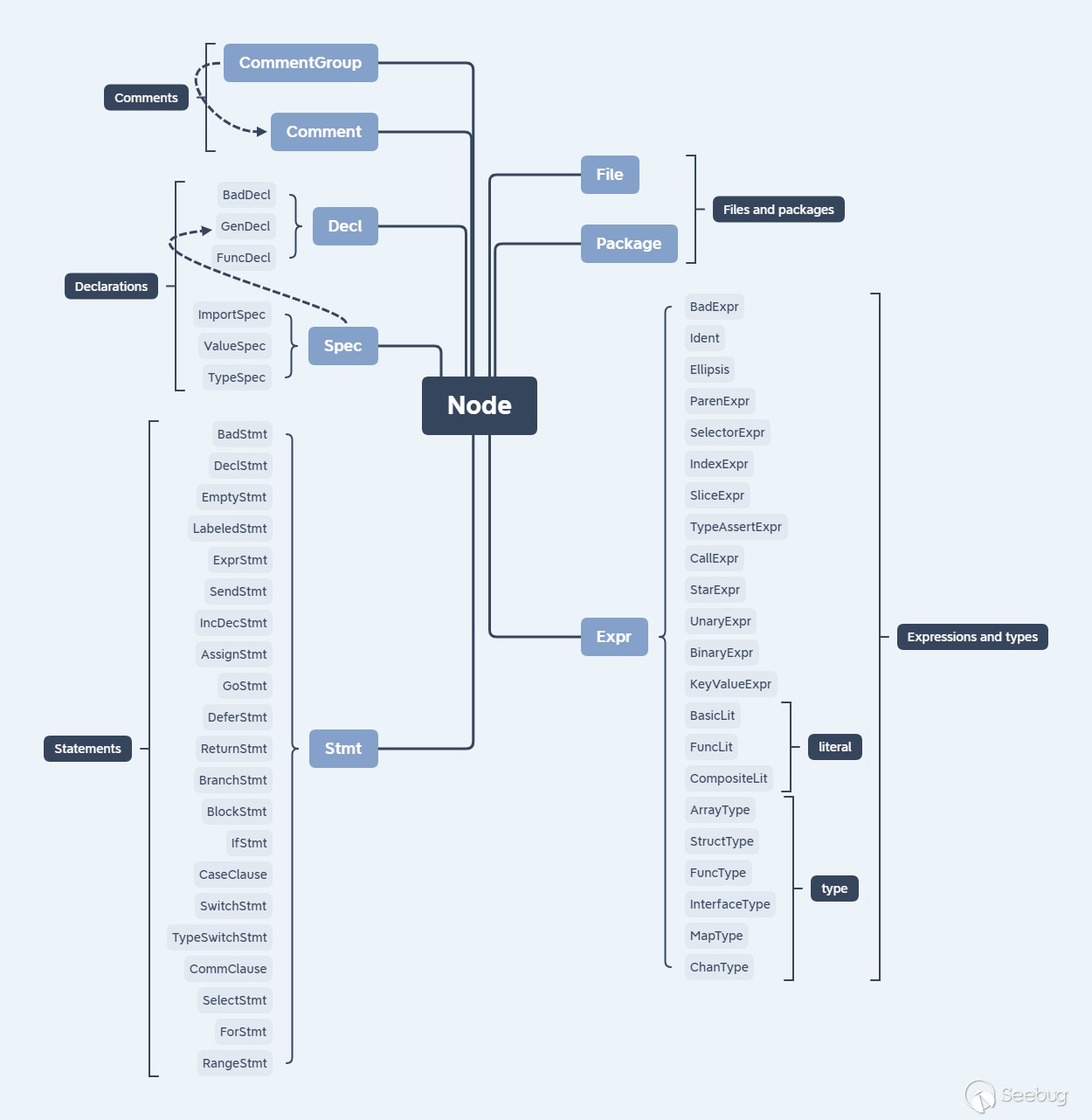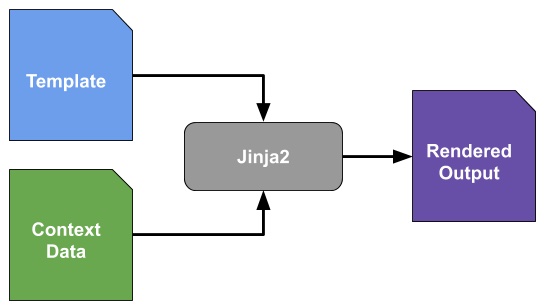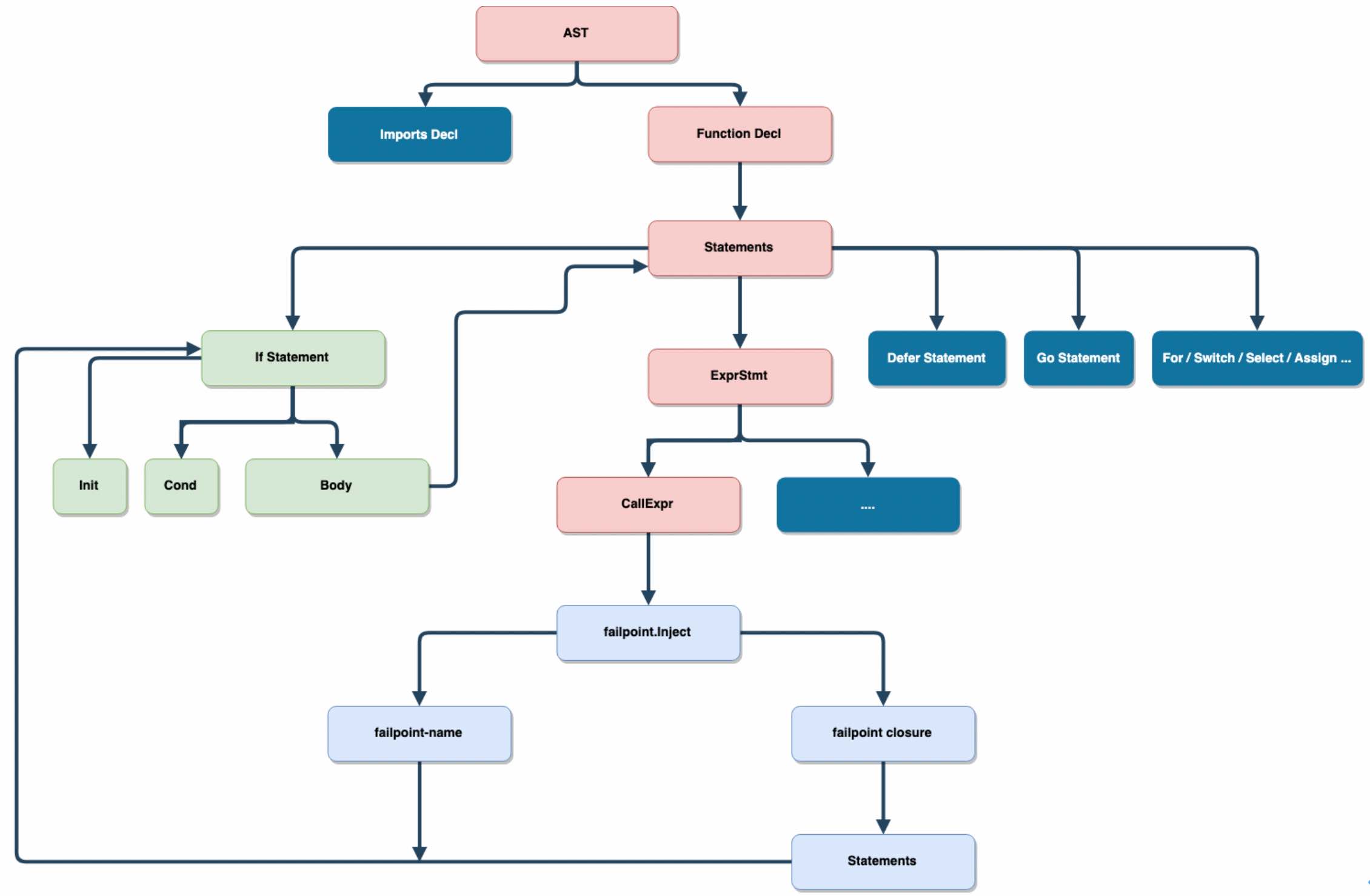最近业务迁移,大约 100+ 个接口需要从旧的服务,迁到公司框架。遇到几个痛点:
结构体 dto 做 diff, 对比结果
自定义的结构体与 protobuf 生成的互相转换,基于 json tag
这类工作要么手写(编译期), 要么 reflect 反射实现(运行时)。其中 #1 考滤到性能问题,手写最优,但是结构体太大,同时 100+ 个接口迁移,工作量可以想象
google 开源的 go-cmp , 输出美观,反射性能开销大了点。当前业务大量使用,堆机器吧又不是不能用
#2 目前不好解决,可以简单的 json Marshal 再 Unmarshal, 但有些字段类型不一致,同时如何做 json tag 到 pb tag 转换呢?
我们当前的方案是通过解析 ast, 读源码生成结构体树,然后 BFS 遍历自动生成转换代码
//go:generate ast-tools –action convert –target-pkg aaa/dto/geresponse –src-pkg bbb/dto –source aaaResponse –target bbbResponse
结合 go generate 自动生成,这是我们的目标
Go AST 基础 不搞编译器的大多只需要懂前端,不涉及 IR 与后端,同时 go 官方还提供了大量开箱即用的库 go/ast
1 2 3 4 type Node interface { Pos() token.Pos End() token.Pos }
所有实现 Pos End 的都是 Node
Comments 注释, //-style 或是 /*-style Declarations 声明,GenDecl (generic declaration node) 代表 import, constant, type 或 variable declaration. BadDecl 代表有语法错误的 nodeStatements 常见的语句表达式,return, case, if 等等File 代表一个 go 源码文件Package 代表一组源代码文件Expr 表达式 ArrayExpr, StructExpr, SliceExpr 等等
我们来看一个例子吧,goast可视化界面 更直观一些
1 2 3 4 5 6 7 8 9 10 type Manager struct { Same string All bool `json:"all"` Version int `json:"-"` NormalStruct pkgcmd.RootApp PointerStruct *pkgcmd.RootApp SlicesField []int MapField map [string ]string }
我们定义结构体 Manager 来看一下 goast 输出结果
1 2 3 4 5 6 7 8 9 10 11 12 13 14 15 16 17 18 19 29 . 1 : *ast.GenDecl {30 . . Doc: nil 31 . . TokPos: foo:7 :1 32 . . Tok: type 33 . . Lparen: -34 . . Specs: []ast.Spec (len = 1 ) {35 . . . 0 : *ast.TypeSpec {36 . . . . Doc: nil 37 . . . . Name: *ast.Ident {38 . . . . . NamePos: foo:7 :6 39 . . . . . Name: "Manager" 40 . . . . . Obj: *ast.Object {41 . . . . . . Kind: type 42 . . . . . . Name: "Manager" 43 . . . . . . Decl: *(obj @ 35 )44 . . . . . . Data: nil 45 . . . . . . Type: nil 46 . . . . . }47 . . . . }
*ast.GenDecl 通用声明,*ast.TypeSpec 代表是个类型的定义,名称是 Manager
1 2 3 4 5 6 7 8 9 10 11 12 13 14 15 16 17 18 19 20 21 22 23 24 25 26 27 28 29 30 48 . Assign: -49 . Type: *ast.StructType {50 . . Struct: foo:7 :14 51 . . Fields: *ast.FieldList {52 . . . Opening: foo:7 :21 53 . . . List: []*ast.Field (len = 7 ) {54 . . . . 0 : *ast.Field {55 . . . . . Doc: nil 56 . . . . . Names: []*ast.Ident (len = 1 ) {57 . . . . . . 0 : *ast.Ident {58 . . . . . . . NamePos: foo:8 :2 59 . . . . . . . Name: "Same" 60 . . . . . . . Obj: *ast.Object {61 . . . . . . . . Kind: var 62 . . . . . . . . Name: "Same" 63 . . . . . . . . Decl: *(obj @ 54 )64 . . . . . . . . Data: nil 65 . . . . . . . . Type: nil 66 . . . . . . . }67 . . . . . . }68 . . . . . }69 . . . . . Type: *ast.Ident {70 . . . . . . NamePos: foo:8 :12 71 . . . . . . Name: "string" 72 . . . . . . Obj: nil 73 . . . . . }74 . . . . . Tag: nil 75 . . . . . Comment: nil 76 . . . . }77 . . . . 1 :
*ast.StructType 代表类型是结构体,*ast.Field 数组保存结构体成员声明,一共 7 个元素,第 0 个字段名称 Same, 类型 string
1 2 3 4 5 6 7 8 9 10 11 12 13 14 15 16 17 18 19 20 21 22 23 24 25 26 27 28 29 30 131 . 3 : *ast.Field {132 . . Doc: nil133 . . Names: []*ast.Ident (len = 1 ) {134 . . . 0 : *ast.Ident {135 . . . . NamePos: foo:11 :2 136 . . . . Name : "NormalStruct" 137 . . . . Obj: *ast.Object {138 . . . . . Kind: var139 . . . . . Name : "NormalStruct" 140 . . . . . Decl: *(obj @ 131 )141 . . . . . Data : nil142 . . . . . Type: nil143 . . . . }144 . . . }145 . . }146 . . Type: *ast.SelectorExpr {147 . . . X: *ast.Ident {148 . . . . NamePos: foo:11 :16 149 . . . . Name : "pkgcmd" 150 . . . . Obj: nil151 . . . }152 . . . Sel: *ast.Ident {153 . . . . NamePos: foo:11 :23 154 . . . . Name : "RootApp" 155 . . . . Obj: nil156 . . . }157 . . }158 . . Tag: nil159 . . Comment: nil160 . }
*ast.SelectorExpr 代表该字段类型是 A.B,其中 A 代表 package, 具体 B 是什么类型不知道,还需要遍历包 A
1 2 3 4 5 6 7 8 9 10 11 12 13 14 15 16 17 18 19 20 21 22 23 24 25 26 27 28 29 30 31 32 221 . 6 : *ast.Field {222 . . Doc: nil 223 . . Names: []*ast.Ident (len = 1 ) {224 . . . 0 : *ast.Ident {225 . . . . NamePos: foo:14 :2 226 . . . . Name: "MapField" 227 . . . . Obj: *ast.Object {228 . . . . . Kind: var 229 . . . . . Name: "MapField" 230 . . . . . Decl: *(obj @ 221 )231 . . . . . Data: nil 232 . . . . . Type: nil 233 . . . . }234 . . . }235 . . }236 . . Type: *ast.MapType {237 . . . Map: foo:14 :21 238 . . . Key: *ast.Ident {239 . . . . NamePos: foo:14 :25 240 . . . . Name: "string" 241 . . . . Obj: nil 242 . . . }243 . . . Value: *ast.Ident {244 . . . . NamePos: foo:14 :32 245 . . . . Name: "string" 246 . . . . Obj: nil 247 . . . }248 . . }249 . . Tag: nil 250 . . Comment: nil 251 . }252 }
*ast.MapType 代表类型是字段,Key, Value 分别定义键值类型
内容有点多,大家感兴趣自行实验
遍历 看懂了 go ast 相关基础,我们就可以遍历获取结构体树形结构,广度 + 深度相结合
1 2 3 4 5 6 7 8 9 10 11 12 13 14 15 16 17 18 19 20 21 22 23 24 25 26 27 28 29 30 31 32 33 34 35 func (p *Parser) IterateGenNeighbours (dir string ) path, err := filepath.Abs(dir) if err != nil { return } p.visitedPkg[dir] = true pkgs, err := parser.ParseDir(token.NewFileSet(), path, filter, 0 ) if err != nil { return } todo := map [string ]struct {}{} for pkgName, pkg := range pkgs { nbv := NewNeighbourVisitor(path, p, todo, pkgName) for _, astFile := range pkg.Files { ast.Walk(nbv, astFile) } for name := range nbv.locals { fmt.Sprintf("IterateGenNeighbours find struct:%s pkg:%s path:%s\n" , name, nbv.locals[name].importPkg, nbv.locals[name].importPath) nbv.locals[name].importSpecs = nbv.importSpec } } for path := range todo { dir := os.Getenv("GOPATH" ) + "/src/" + strings.Replace(path, "\"" , "" , -1 ) if _, visited := p.visitedPkg[dir]; visited { continue } p.IterateGenNeighbours(dir) } }
这里的工作量比较大,涉及 import 包,调试了很久,有些 linter 只需读单一文件即可,工作量没法比
模板输出 最后一步就是输出结果,这里要 BFS 广度遍历结构体树,然后渲染模板
1 2 3 4 5 6 7 8 9 10 11 12 var convertSlicePointerScalarTemplateString = ` {% if ArrayLength == "" %} dst.{{ TargetFieldName }} = make([]{{ TargetType }}, len(src.{{ SrcFieldName }})) {% endif %} for i := range src.{{ SrcFieldName }} { if src.{{ SrcFieldName }}[i] == nil { continue } tmp := *src.{{ SrcFieldName }}[i] dst.{{ TargetFieldName }}[i] = &tmp }
上面是转换 [8]*Scalar 可以是数组或切片,模板使用 pongo2 实现的 jinji2 语法,非常强大
1 2 3 4 5 6 7 8 9 10 11 12 13 14 15 16 17 18 19 func ConvertDtoInsuranceOptionToCommonInsuranceOptionV2 (src *dto.InsuranceOption) *common .InsuranceOptionV2 if src == nil { return nil } dst := &common.InsuranceOptionV2{} dst.ID = src.ID dst.OptionPremium = src.OptionPremium dst.InsuranceSignature = src.InsuranceSignature dst.Title = src.Title dst.Subtitle = src.Subtitle dst.ErrorText = src.ErrorText dst.IsIncluded = src.IsIncluded starCurrency := ConvertDtoCurrencyDTOToCommonCurrencyDTO(src.Currency) if starCurrency != nil { dst.Currency = *starCurrency } return dst }
上面是输出结果的样例,整体来讲比手写靠谱多了,遇到个别 case 还是需要手工 fix
AST 其它应用场景 1. 规则 工作当中用到编译原理的场景非常多,比如去年高老板分享的用规则引擎让你一天上线十个需求
1 2 3 4 5 6 7 If aa.bb.cc == 1 Unmarshal(bb.cc.ee) 看type 是否为 4 else Unmarshal(bb.cc.ff) 看type 是否为 4 (type = 4 的是拼车)
业务需要多种多样,订阅 MQ 根据需求做各种各样的统计,入库,供业务查询。如果业务类型少还好,但是 DIDI 业务复杂,如果每次都人工手写 go 代码效率太低
最后解决思路是 JPATH + Expression Eval, 需求只需要写表达式,服务解析表达示即可。Eval 库也是现成的 govaluate
2. 模板 jinja2 就是这类的代表
原理非常简单,感兴趣的可以看官方实现
3. Inject 代码 这里要介绍两个项目 pingcap failpoint 和 uber-go 的 gopatch
failpoint 实现很简单,代码里写 Marker 函数,这些空函数在正常编译时会被编译器优化去掉,所以正常运行时 zero-cost
1 2 3 4 var outerVar = "declare in outer scope" failpoint.Inject("failpoint-name-for-demo" , func (val failpoint.Value) fmt.Println("unit-test" , val, outerVar) })
故障注入时通过 failctl 将 Marker 函数转换为故障注入函数,这里就用到了 go-ast 做劫持转换
uber-go 的 gopatch 也非常强大,假如你的代码有很多 go func 开启的 goroutine, 你想批量加入 recover 逻辑,如果数据特别多人工加很麻烦,这时可以用 gopatcher
1 2 3 4 5 6 7 8 9 10 11 12 13 14 15 16 var patchTemplateString = `@@ @@ + import "runtime/debug" + import "{{ Logger }}" + import "{{ Statsd }}" go func(...) { + defer func(){ + if err := recover(); err != nil { + statsd.Count1("{{ StatsdTag }}", "{{ FileName }}") + logging.Error("{{ LoggerTag }}", "{{ FileName }} recover from panic, err=%+v, stack=%v", err, string(debug.Stack())) + } + }() ... }() `
编写模板,上面的例子自动在 go func(...) { 开头注入 recover 语句块,非常方便
这个库能做的事情特别多,感兴趣自行实验
4. linter 大部分 linter 工具都是用 go ast 实现的,比如对于大写的 Public 函数,如果没有注释报错
1 2 3 4 5 6 func BuildArgs () var a int a = a + bbb.c return a }
我们看下该代码的 ast 代码
1 2 3 4 5 6 7 8 9 10 11 12 13 14 15 16 17 18 19 20 21 29 . . 1 : *ast.FuncDecl {30 . . . Doc: *ast.CommentGroup {31 . . . . List : []*ast.Comment (len = 1 ) {32 . . . . . 0 : *ast.Comment {33 . . . . . . Slash: foo:7 :1 34 . . . . . . Text: "// BuildArgs write a" 35 . . . . . }36 . . . . }37 . . . }38 . . . Recv: nil39 . . . Name : *ast.Ident {40 . . . . NamePos: foo:8 :6 41 . . . . Name : "BuildArgs" 42 . . . . Obj: *ast.Object {43 . . . . . Kind: func44 . . . . . Name : "BuildArgs" 45 . . . . . Decl: *(obj @ 29 )46 . . . . . Data : nil47 . . . . . Type: nil48 . . . . }49 . . . }
linter 只需要检查 FuncDecl 的 Name 如果是可导出的,同时 Doc.CommentGroup 不存在,或是注释不以函数名开头,报错即可
另外如果大家对代码 cycle 有要求,那么是不是可以 ast 扫一遍来发现呢?如果大家要求函数不能超过 100 行,是不是也可以实现呢?
玩法很多 ^^
小结 编译原理虽然难,但是搞业务的只需要前端知识即可,不用研究的太深,有需要的场景,知道 AST 如何解决问题就行
今天的分享就这些,写文章不容易,如果对大家有所帮助和启发,请大家帮忙点击再看,点赞,分享 三连
关于 Go AST 大家有什么看法,欢迎留言一起讨论,大牛多留言 ^_^




